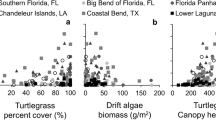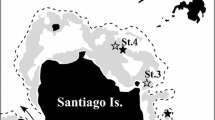Abstract
We used growth rates of juvenile winter flounderPseudopleuronectes americanus to assess anthropogenic influence on habitat quality at three sites in Narragansett Bay, Rhode Island. The upper bay site, Gaspee Point, had the highest population density and concentration of total nitrogen; human inputs decreased down bay. Growth rates of individually marked fish were measured in three 15-d experiments from June 8 to July 6, 1998 in 1-m2 cages placed at upper, middle, and lower bay sites. Water temperature, salinity, dissolved oxygen (DO), and benthic food were also measured. Stable isotopes of nitrogen and carbon were measured in experimental fish as possible indicators of nutrient enrichment and to identify organic carbon sources. Growth rates were 0.22–0.60 mm d−1, with the highest average at the mid-bay site. Growth was initially fastest at Gaspee Point, but dropped off as DO concentrations fell. Step-wise multiple regression indicated that location (upper, middle, or lower bay) explained most of the variability in fish growth (40%). Coefficients of other significant variables indicated that fish grew faster at lower salinities, smaller sizes, and with decreased time that DO was below 2.3 mg l−1. Benthic prey varied among sites and there was significantly less food and fewer species at Gaspee Point.Polydora cornuta was a favored food at all sites and was found in over half the stomachs. Values of δ15N in fish and sediments did not reflect differences in total nitrogen concentrations recorded near the sites. We suggest that anthropogenic influences, such as nutrients and sewage, affected habitat quality by reducing DO, which lowered fish growth rates.
Similar content being viewed by others
Literature Cited
Able, K. W., J. P. Manderson, andA. L. Studholme. 1999. Habitat quality for shallow water fishes in an urban estuary: The effects of man-made structures on growth.Marine Ecology Progress Series 187:227–235.
Bejda, A. J., B. A. Phelan, andA. L. Studholme. 1992. The effect of dissolved oxygen on the growth of young-of-the-year winter flounder,Pseudopleuronectes americanus.Environmental Biology of Fishes 34:321–327.
Carlson, J. K., T. A. Randall, andM. E. Mroczka. 1997. Feeding habits of winter flounder (Pleuronectes americanus) in a habitat exposed to anthropogenic disturbance.Journal of Northwest Atlantic Fishery Science 21:65–73.
Currin, C. A., S. Y. Newell, andH. W. Paerl. 1995. The role of standing deadSpartina alterniflora and benthic microalgae in salt marsh food webs: Considerations based on multiple stable isotope analysis.Marine Ecology Progress Series 121:99–116.
DeLong, A., J. Collie, C. Meise, and J. C. Powell. In press. Estimating growth and mortality of juvenile winter flounder,Pseudopleuronectes americanus, with a length-based model.Canadian Journal of Fisheries and Aquatic Sciences.
Duffy-Anderson, J. T. andK. W. Able. 1999. Effects of municipal piers on the growth of juvenile fishes in the Hudson River estuary: A study across a pier edge.Marine Biology 133:409–418.
Elderfield, H., N. Ludtke, R. T. McCaffrey, andM. Bender. 1981. Benthic flux studies in Narragansett Bay.American Journal of Science 281:768–787.
Fry, B. 1988. Food web structure on Georges Bank from stable C, N, and S isotopic compositions,Limnology and Oceanography 33:1182–1190.
Fry, B. andE. B. Sherr. 1984. δ13C measurements as indicators of carbon flow in marine and freshwater ecosystems.Contributions to Marine Science 27:13–47.
Guindon, K. Y. andJ. M. Miller. 1995. Growth potential of juvenile southern flounder,Paralichthys lethostigma, in low salinity nursery areas of Pamlico Sound, North Carolina, USA.Netherlands Journal of Sea Research 34:89–100.
Haines, E. B. andC. L. Montague. 1979. Food sources of estuarine invertebrates analyzed using13C/14C ratios.Ecology 60: 48–56.
Hobson, K. A. andH. E. Welch. 1995. Cannibalism and trophic structure in a high Arctic lake: Insights from stable isotope analysis.Canadian Journal of Fisheries and Aquatic Sciences 52: 1195–1201.
Howell, P. T., D. R. Molnar, andR. B. Harris. 1999. Juvenile winter flounder distribution by habitat type.Estuaries 22:1090–1095.
Howell, P. T. andD. Simpson. 1994. Abundance of marine resources in relation to dissolved oxygen in Long Island Sound.Estuaries 17:394–402.
Keller, A. A., G. Klein-MacPhee, andJ. St. Onge Burns. 1999. Abundance and distribution of ichthyoplankton in Narragansett Bay, Rhode Island.Estuaries 22:149–163.
Keough, J. R., M. E. Sierszen, andC. A. Hagley. 1996. Analysis of a Lake Superior coastal food web with stable isotope techniques.Limnology and Oceanography 41:136–146.
Laurence, G. C. 1975. Laboratory growth and metabolism of the winter flounderPseudopleuronectes americanus from hatching through metamorphosis at three temperatures.Marine Biology 32:223–229.
Lee, V. andS. Olsen. 1985. Eutrophication and management initiatives for the control of nutrient inputs to Rhode Island coastal lagoons.Estuaries 8:191–202.
McClelland, J. W., I. Valiela, andR. H. Michener. 1997. Nitrogen-stable isotope signatures in estuarine food webs: A record of increasing urbanization in coastal wetlands.Limnology and Oceanography 42:930–937.
Meng, L., C. Gray, B. Taplin, andE. Kupcha. 2000. Using winter flounder growth rates to assess habitat quality in Rhode Island's coastal lagoons.Marine Ecology Progress Series 201:287–299.
Meng, L. andJ. C. Powell. 1999. Linking juvenile fish and their habitats: An example from Narragansett Bay, Rhode Island.Estuaries 22:860–871.
Moore, M. J., D. Shea, R. E. Hillman, andJ. J. Stegman. 1996. Trends in hepatic tumors and hydropic vacuolation, fin erosion, organic chemicals and stable isotope ratios in winter flounder from Massachusetts, USA.Marine Pollution Bulletin 32:458–470.
Nixon, S. W. 1992. Quantifying the relationship between nitrogen input and the productivity of marine ecosystems, p. 57–83.In M. Takahashi, K. Nakata, and T. R. Parsons (eds.), Proceedings of Advanced Marine Technology Conference. Vol. 5. Advanced Marine Technology Conference, Tokyo, Japan.
Nixon, S. W. andV. Lee. 1979. Spatial and temporal pollution gradients in Narragansett Bay. C.M. 1979/E: 56, Water Quality Committee, International Council for the Exploration of the Sea, Warsaw, Poland.
Olsen, S., D. D. Robadue, Jr., and V. Lee. 1980. An Interpretive Atlas of Narragansett Bay. Coastal Resources Center, University of Rhode Island Marine Bulletin 40, Narragansett, Rhode Island.
Oviatt, C. A. andS. W. Nixon. 1973. The demersal fish of Narragansett Bay: An analysis of community structure, distribution and abundance.Estuarine and Coastal Marine Science 1: 361–378.
Oviatt, C. A., M. E. Pilson, S. W. Nixon, J. B. Frithsen, D. T. Rudnick, J. R. Kelly, J. F. Grassle, andJ. P. Grassle. 1984. Recovery of a polluted estuarine system: A mesocosm experiment.Marine Ecology Progress Series 16:203–217.
Percy, W. G. 1962. Ecology of an estuarine population of winter flounderPseudopleuronectes americanus (Walbaum). III. Distribution, abundance, growth, and production of juveniles; survival of larvae and juveniles.Bulletin of the Bingham Oceanographic Collection 18:39–64.
Phelan, B. A., R. Goldberg, A. J. Bejda, J. Pereira, S. Hagan, P. Clark, A. L. Studholme, A. Calabrese, andK. W. Able. 2000. Habitat specific growth of young-of-the-year winter flounder (Pseudopleuronectes americanus) and tautog (Tautoga onitis) in three Northeastern U.S. estuaries.Journal of Experimental Marine Biology 247:1–28.
Polgar, T. T., J. K. Summers, R. A. Cummins, K. A. Rose, andD. G. Heimbuch. 1985. Investigation of relationships among pollutant loadings and fish stock levels in northeastern estuaries.Estuaries 8:125–135.
Santschi, P. H., S. Nixon, M. E. Q. Pilson, andC. Hunt. 1984. Accumulation of sediments, trace metals (Cu, Pb) and hydrocarbons in Narragansett Bay, Rhode Island.Estuarine and Coastal and Shelf Science 19:427–449.
SAS Institute. 1988. SAS User's Guide, Version 6.03. SAS Institute, Cary, North Carolina.
Sogard, S. M. 1992. Variability in growth rates of juvenile fishes in different estuarine habitats.Marine Ecology Progress Series 85: 35–53.
Sogard, S. M. andK. W. Able. 1992. Growth variation of newly settled winter flounder (Pseudopleuronectes americanus) in New Jersey estuaries as determined by otolith microstructure.Netherlands Journal of Sea Research 29:163–172.
Stephenson, R. L., F. C. Tan, andK. H. Mann. 1986. Use of stable carbon isotope ratios to compare plant material and potential consumers in a sea grass bed and a kelp bed in Nova Scotia, Canada,Marine Ecology Progress Series 30:1–7.
Tucker, J., N. Sheats, A. E. Giblin, C. S. Hopkinson, andJ. P. Montoya. 1999. Using stable isotopes to trace sewage-derived material through Boston Harbor and Massachusetts Bay.Marine Environmental Research 48:353–375.
Valente, R. M., D. C. Rhoads, J. D. Germano, andV. J. Cabelli. 1992. Mapping of benthic enrichment patterns in Narragansett Bay, Rhode Island.Estuaries 15:1–17.
Valiela, I., K. Foreman, M. LaMontagne, D. Hersh, J. Costa, P. Feckol, B. DeMeo-Anderson, C. D'Avanzo, M. Babione, C. Sham, J. Brawley, andK. Lajtha. 1992. Couplings of watersheds and coastal waters: Sources and consequences of nutrient enrichment in Waquoit Bay, Massachusetts.Estuaries. 15: 443–457.
Vander Zanden, M. J., G. Cabana, andJ. B. Rasmussen. 1997. Comparing trophic position of freshwater fish calculated using stable nitrogen isotope ratios (ϕ15N) and literature dietary data.Canadian Journal of Fisheries and Aquatic Sciences 54:1142–1158.
Van Vleet, E. S. andJ. G. Quinn. 1978. Contribution of chronic petroleum inputs to Narragansett Bay and Rhode Island sediments.Journal of the Fisheries Research Board of Canada 35:536–543.
Wainwright, S. C., M. J. Fogarty, R. C. Greenfield, andB. Fry. 1993. Long-term changes in the Georges Bank food web: Trends in stable isotopic compositions of fish scales.Marine Biology 115:481–493.
Wainwright, S. C., C. M. Fuller, R. H. Michener, andR. A. Richards. 1996. Spatial variation of trophic position and growth rate of striped bass (Morone saxatilis) in the Delaware River.Canadian Journal of Fisheries and Aquatic Sciences 53:685–692.
Yelenik, S., J. McCelland, N. Feinstein., andI. Valiela. 1996. Changes in stable isotope signatures of particulate organic matter and ribbed mussels in estuaries subject to different nutrient loading.Biological Bulletin 191:329–330.
Source of Unpublished Materials
Oviatt, C. A., A. A. Keller, and L. Reed. In review. Primary production patterns in Narragansett Bay during a year with no bay-wide winter-spring diatom bloom,Estuarine, Coastal and Shelf Science.
Author information
Authors and Affiliations
Corresponding author
Rights and permissions
About this article
Cite this article
Meng, L., Powell, J.C. & Taplin, B. Using winter flounder growth rates to assess habitat quality across an anthropogenic gradient in Narragansett Bay, Rhode Island. Estuaries 24, 576–584 (2001). https://doi.org/10.2307/1353258
Received:
Accepted:
Issue Date:
DOI: https://doi.org/10.2307/1353258




